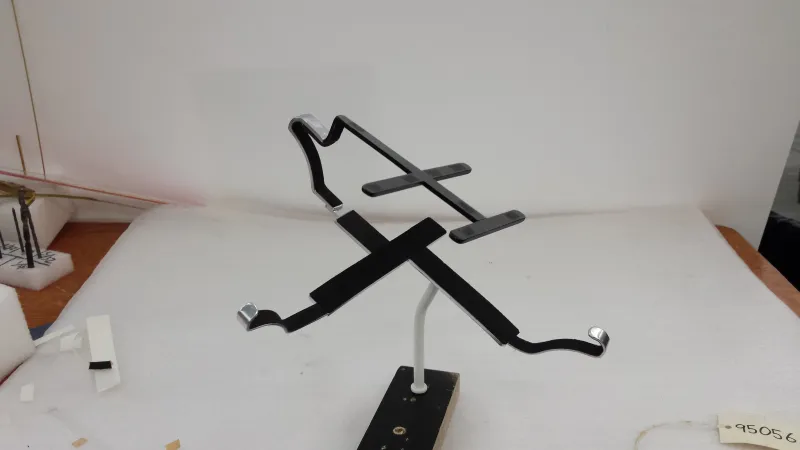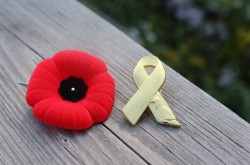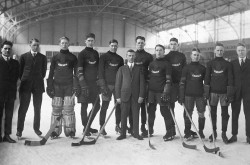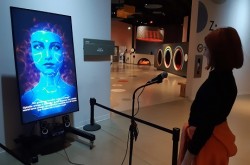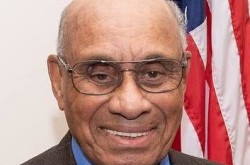Dans les Coulisses: Rencontrez les créateurs de supports du Musée des sciences et de la technologie du Canada

Plus de 2 900 artefacts sont exposés dans les diverses galeries du nouveau Musée des sciences et de la technologie du Canada. Avant sa réouverture, en novembre 2017, une petite équipe a travaillé sans relâche durant près d’une année à la conception et à la création des interfaces et des supports destinés à tous les objets exposés. Le Réseau s’est entretenu avec trois membres de cette équipe afin de savoir comment ils opèrent leur magie dans les coulisses pour concevoir tous ces supports.
Noms : Kenn Bingley, Giuseppe Crupi et Derek Brousseau
En quoi consiste votre travail?
« Lorsqu’un objet doit être exposé, nous travaillons avec l’équipe artistique, l’équipe de conception et le conservateur du musée. Nous travaillons aussi avec le côté plus technique : les gens des collections et de la conservation. Nous nous efforçons d’installer les objets sur des présentoirs qui les mettront en valeur, qui illustreront bien l’histoire que veut raconter le conservateur, mais également qui en assureront la sécurité. Notre cheminement pour y arriver repose sur la personne et ses talents. Nous travaillons avec toutes sortes de matériaux : bois, plastiques, laiton, acier, acier inoxydable, n’importe quel matériau requis. »
—Kenn Bingley
Combien de temps faut-il pour fabriquer un support?
« Certaines choses ne prennent qu’une heure, mais j’ai déjà fait un support [pour le Musée des sciences et de la technologie du Canada] qui m’a demandé une semaine et demie de travail. C’était pour une borne de démarcation d’Halifax… 590 kilogrammes (1 300 lb) de pierre. Il fallait fabriquer un gros cadre pour le support, en raison du poids de l’objet. Il a aussi fallu beaucoup de temps dans le cas d’un drapeau du Canada, qui est maintenant exposé dans l’Allée des artefacts, en raison de la façon dont les responsables voulaient qu’il soit exposé. Il devait avoir l’air d’onduler. Nous ne pouvions pas y faire de points, puisque cela l’aurait endommagé, et nous ne pouvions pas non plus utiliser d’aimants, puisque le drapeau serait exposé longtemps et il aurait fini par étirer aux endroits retenus par les aimants. Nous avons donc dû concevoir un support à presse, chose que nous n’avions jamais faite. Parfois, on tient des choses pour acquis, bon, on sait qu’on va concevoir un support, et tout à coup, on doit retourner à la planche à dessin. »
Créer un support pour un drapeau canadien
What considerations do you need to make when deciding what material to use for a mount?
“The first consideration is artifact safety. For most mounts we can use a variety of materials, but certain materials are easier to work with. The materials we use most are brass and steel. For a paper artifact, we can use acrylic, however, sometimes people don’t like acrylic because it’s shinier and more obvious.”
—Derek Brousseau
“We always look at the safety of the object first, but a close second is esthetics; we’re always looking for different ways to mount things.”
—Kenn Bingley
“There also has to be an interface between the materials we use and the object. The amount of time the object will be display affects the choice of material, too – because things will start to off-gas, which can damage the object. I think the best mounts we do is when we don’t see it at all – so we try to make it hidden. When we’re good at our job, no one even notices.”
—Giuseppe Crupi
What were some of the most interesting challenges you faced while preparing mounts for the museum opening?
“I became known as the mount boat specialist. I did a mount for a 33-ft birch bark canoe at the Canadian Museum of History, so I had a St-Lawrence skiff that was going on display here [at the Canada Museum of Science and Technology]. I pretty well did the same style – and it worked great.”
—Derek Brousseau
“I worked on a waffle maker in the sci-fi section – it’s there because it looks like a UFO. I suggested having the waffle maker look like it’s flying through the air. It’s open – so you can tell it’s a waffle maker. That’s an example of adding design elements to a mount. We always try to have the artifacts animated, because if you ever see an exhibit where everything’s just sitting there, it’s boring. So sometimes we have things that are off the wall, that are coming out at you.”
—Giuseppe Crupi
Creating a mount for a waffle maker
“Sometimes curators have a very specific vision; they can show you an object in a way that you would not have imagined it. I worked on a “smart coat” in the Wearable Tech gallery. Tom Everett, the curator, wanted the coat to kindof look like it was floating and interacting with itself; the idea was it’s a smart coat and had all this technology – he wanted to show off the different bits of technology. I didn’t really understand what was significant about the coat until I spoke to him. From there, I was able to make a mount that showed off what he thought was special about it. It’s fun to help somebody else have their vision come forward, or work right alongside them.”
—Kenn Bingley
What kind of training do the three of you have?
“I have a fine arts degree, and I completed Museum Studies at Algonquin College. I worked in collections at the Canadian War Museum before coming here. It’s all on-the-job training. Woodworking and welding tie in, but you need the Museum Studies.”
—Kenn Bingley
“I took the Building Construction Technician program at Algonquin College, followed by the Museum Studies program at Algonquin. I taught myself welding while I was building my truck. Previously, I worked at the Canadian Museum of History. If you’re a mountmaker, you need to know how everything works, how everyone comes together; you can’t really do it by yourself. You have to coordinate with collections, conservation, curators, and project managers – and ask lots of questions.”
—Derek Brousseau
“I have a degree in history, and I completed the Museum Studies program at Algonquin College. There’s not that many people who do this, so you need to learn the craft from someone else.”
Giuseppe Crupi
What personal attributes do you need for your job?
“A big part of the job is managing your time and knowing how long things are going to take. Considering it’s sortof a creative process, that’s a bit difficult to do sometimes. Plans always change; often mounts will need to be modified. We’re in an interesting spot in that we’re between the planning and the actual reality.”
—Kenn Bingley
“You have to be creative and resourceful. That’s why I love what I do, because you’re thinking outside of the box every day. Each challenge is different in some way – it keeps you on your toes.”
—Derek Brousseau










